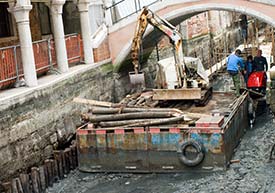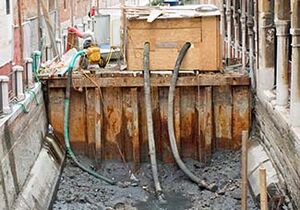Dry Dredging

Dry dredging is a more costly and time consuming process used to remove a large amount of dispersed sediment or repair other Urban Elements such as the canal walls, Sewers, Bridges, and sometimes Utilities. The benefit to dry dredging is the ability to quantify the amount of sediment removed and measure the depth of the canal more accurately. Also as mentioned above an efficient inspection of the Canal, Canal Wall, and Sewer can be done. The disadvantage to dry dredging is the time consumed by preparing the Canal for the procedure.[1]
Preparation

First a Cofferdam is set up and the Canal is drained. These Cofferdams are temporary walls which are erected to seal off a Canal Segment. Once the Cofferdams are set up the water can be pumped out of the Canal Segment using water pumps. The work crew must also set up a system of temporary rails and walk ways to allow access to the canal walls and the exportation of collected silt.
Process
After preparing the Canal removal of sediment can be performed. The Sludge is shoveled into a hopper on some sort of wheeled vehicle by a hydraulic shovel, backhoe or crane.[2] More times than not the industrial shovels cannot remove all of the sludge so workers often times finish this step by using hand shovels to remove the remaining rubbish.
Other Maintenance
Often times in a dry dredging process other urban elements that would usually be accessible due to the presence of the water in a Canal are maintained. For example with the Canal drained workers are able to inspect the Canal Wall and determine if any Maintenance is required. Other elements that can be restored during a dry dredging project are the foundations and undersides of a Bridge, the Gatoli can be cleaned, and if there are any Utility lines running along the canal floor (which is rare).
Clean up
After all desired Maintenance is performed the crew can begin to break down the project. The collected sludge is first disposed of. Then all tools and machinery is removed from the Canal using the system of ramps constructed. Next the temporary ramps and rails can be collected. One last inspection of the Canal is done to be sure nothing has been left before re flooding the Canal and breaking down the Cofferdams.
References
- ↑ Dredging Methods, http://www.aquamogmidwest.com/Contemporary_Dredging_Metho.html
- ↑ Maintaining Venice’s Canals, Venice for Visitors, http://europeforvisitors.com/venice/articles/maintaining_venices_canals.htm